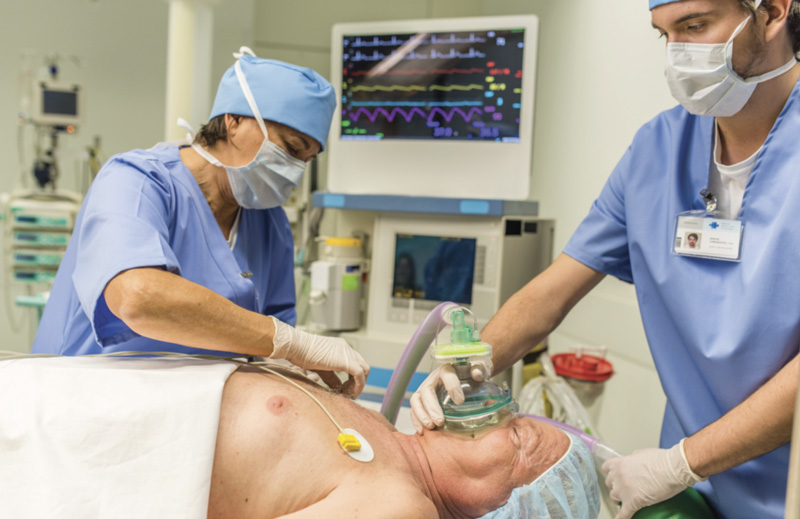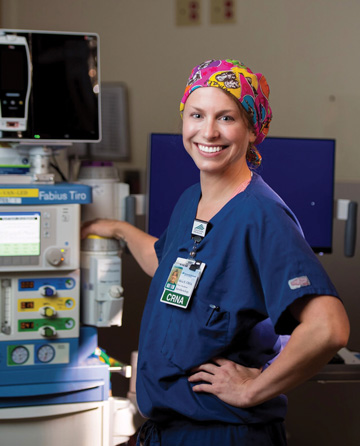• Overall savings. Drs. Edmonds and Stambaugh coauthored a study on low-flow anesthesia published earlier this year in AANA Journal. The paper examined the cost savings and reduction in environmental release enabled by the technique. “Anesthesia gases on the whole are very cheap,” says Dr. Edmonds. “Most hospitals don’t even pay attention to their
expense because it’s such a small blip in the overall cost of care. Our hospital alone could have saved over $50,000 a year by running low flows of anesthesia. That doesn’t seem like very much when you look at the high cost of
running ORs all day, but it’s not nothing.”
To drive home the cost and waste savings benefits, surgical administrators could monitor gas usage, either in the aggregate or by individual providers. “Most anesthesia machines are sophisticated enough to track specific flows,” says
Dr. Stambaugh.
Administrators could dig a little deeper and research what the gas is costing and what they could save. This analysis is powerful and can be used to approach individual providers to inform them of their current practice, present the research and
data, and share the cost and environmental savings they’d realize by implementing low-flow anesthesia. “It can be mind-blowing to anesthesia providers that they can have this huge effect,” says Dr. Edmonds.
Anesthestic gases act as greenhouse gases. “They affect the atmosphere for many years, and trap more heat than carbon dioxide,” says Dr. Edmonds. “Studies have shown they contribute to climate change, and anesthesia providers
are more aware of their negative effects on the environment.”
Because the benefits of low-flow anesthesia are two-pronged — saving money and saving the environment — most anesthesia professionals will be attracted to at least one cause. “Some providers respond to the cost aspect, but others
say, ‘Well, it’s not coming out of my pocket, I don’t care,’” says Dr. Edmonds. “The environmental piece might be near and dear to their hearts because they exist in this world and want to preserve it.”
• Safe administration. Anesthesia providers who employ low-flow anesthesia need a comprehensive knowledge of the anesthetic drugs they use, understand the anesthesia machines they’re using at a fundamental level and monitor
the amount of oxygen their patients need, according to Dr. Philip.
Dr. Stambaugh says a major component of low-flow anesthesia is gas chromatography. Anesthesia providers place a sample line that goes from the breathing circuit to the anesthesia machine. “It tells us the percent of gas the patient is inhaling
and exhaling, which gives us the scientific knowledge to know the patient is going to be amnestic,” says Dr. Stambaugh. “If you think of breath as a tidal volume, the patient’s end tidal percentage of gas is measured at the
end of an exhale. The gas sampling tells us the end tidal percentage. That’s how we know we’re administering low-flow safely.”
The patient has a deep level of anesthesia the whole time, but I’m doing it in a smarter way.
— Hilary Stambaugh, DNAP, CRNA
Some industry concern exists regarding the use of low-flow sevoflurane because of a breakdown product called Compound A that is produced when the gas interacts with carbon dioxide absorbents in the anesthesia machine, which are meant to scrub
CO2 from the breathing circuit so the patient doesn’t rebreathe it along with a high concentration of sevoflurane.
Early studies examined whether Compound A caused kidney injuries and found that low-flow sevoflurane can produce Compound A. But multiple randomized control trials and meta-analyses of randomized control trials have yet to determine that Compound
A causes any recognizable dip in kidney function.
Studies and statistics have shown Compound A is not an issue — even during lengthier cases, according to Dr. Edmonds. “We’re not saying that Compound A doesn’t exist,” she says. “We’re saying humans don’t
break it down the same as has been shown in animal studies. That’s true in pediatric populations, elderly populations and populations that have a history of kidney disease.”
The CO2 absorbers that were producing Compound A are no longer in use at most facilities due to a switch from potassium hydroxide to calcium hydroxide in modern absorbers. “The CO2 absorbents available now are less reactive, and you can
buy versions that are essentially nonreactive,” says Dr. Philip. “The most reactive of the CO2 absorbents haven’t been on the market for a while.”
The bottom-line question: Are clinical concessions made using low-flow technology? “Not one,” emphasizes Dr. Edmonds.
.svg?sfvrsn=be606e78_3)


.svg?sfvrsn=56b2f850_5)